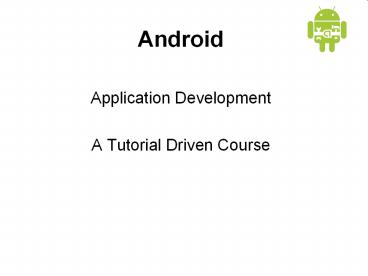Android - PowerPoint PPT Presentation
Title:
Android
Description:
Android Application Development A Tutorial Driven Course End of Lecture First task, install the SDK and Eclipse Next, build hello world app End of Lecture First ... – PowerPoint PPT presentation
Number of Views:256
Avg rating:3.0/5.0
Title: Android
1
Android
- Application Development
- A Tutorial Driven Course
2
Java
- Basic Java programming
- Exceptions
- Inner Class, Interface
- Advanced topics we will touch
- Java IO
- Java Thread
- Java Socket
3
Android Basics
- Credit goes to Google!
4
Course Objectives
- Mobile Application Development (MAD)
- Intro to Android platform
- Platform architecture
- Application building blocks
- Development tools
- Textbook Hello, Android
5
Few reasons to go MAD
- Smart Phones
- Internet access anywhere
- Social networking
- Millions of mobile users
- Open standards
6
Introduction to Android
- Open software platform for mobile development
- A complete stack OS, Middleware, Applications
- An Open Handset Alliance (OHA) project
- Powered by Linux operating system
- Fast application development in Java
- Open source under the Apache 2 license
7
(No Transcript)
8
Linux Kernel
- Works as a HAL
- Device drivers
- Memory management
- Process management
- Networking
9
Libraries
- C/C libraries
- Interface through Java
- Surface manager Handling UI Windows
- 2D and 3D graphics
- Media codecs, SQLite, Browser engine
10
Android Runtime
- Dalvik VM
- Dex files
- Compact and efficient than class files
- Limited memory and battery power
- Core Libraries
- Java 5 Std edition
- Collections, I/O etc
11
Application Framework
- API interface
- Activity manager manages application life cycle.
12
Applications
- Built in and user apps
- Can replace built in apps
13
Course Objectives
- Mobile Application Development (MAD)
- Intro to Android platform
- Platform architecture
- Application building blocks
- Development tools
- Textbook Hello, Android
14
Application Building Blocks
- Activity
- IntentReceiver
- Service
- ContentProvider
15
Activities
- Typically correspond to one UI screen
- But, they can
- Be faceless
- Be in a floating window
- Return a value
16
IntentReceivers
- Components that respond to broadcast Intents
- Way to respond to external notification or alarms
- Apps can invent and broadcast their own Intent
17
Intents
- Think of Intents as a verb and object a
description of what you want done - E.g. VIEW, CALL, PLAY etc..
- System matches Intent with Activity that can best
provide the service - Activities and IntentReceivers describe what
Intents they can service
18
Intents
System picks best component for that action
Home
Photo Gallery
Contacts
Pick photo
GMail
Client component makes a request for a specific
action
Chat
Blogger
Blogger
New components can use existing functionality
19
Services
- Faceless components that run in the background
- E.g. music player, network download etc
20
ContentProviders
- Enables sharing of data across applications
- E.g. address book, photo gallery
- Provides uniform APIs for
- querying
- delete, update and insert.
- Content is represented by URI and MIME type
21
Course Objectives
- Mobile Application Development (MAD)
- Intro to Android platform
- Platform architecture
- Application building blocks
- Development tools
- Textbook Hello, Android
22
Development Tools
- Eclipse
- Android SDK 2.0 or higher
- developer.android.com
23
The Emulator
- QEMU-based ARM emulator
- Runs the same image as the device
- Limitations
- No Camera support
24
Devices
25
Hello World
- A great starting point http//developer.android.c
om/guide/tutorials/hello-world.html - Generating UIs
- Views building blocks
- E.g. TextView, EditText, Button
- Placed into Layouts
- E.g. LinearLayout, TableLayout, AbsoluteLayout
26
Application Lifecycle
- Application run in their own processes (VM, PID)
- Processes are started and stopped as needed to
run an application's components - Processes may be killed to reclaim resources
27
(No Transcript)
28
Lifecycle
- System Process
- Home
- Browser
Home
- Map
Contacts
GMail
29
Location Manager
30
XMPP Services
- Allows any app to send device-to-device messages
to other android users - Data Messages are Intents with name/value pairs
- Works with any gmail account
- Can also build servers to deliver
server-to-device messages
31
Notification Manager
32
Notification Manager
- How background app interact with users
- Consistent notification presentation
33
Views
34
Views
35
Location Manager
36
End of Lecture
- First task, install the SDK and Eclipse
- Next, build hello world app































